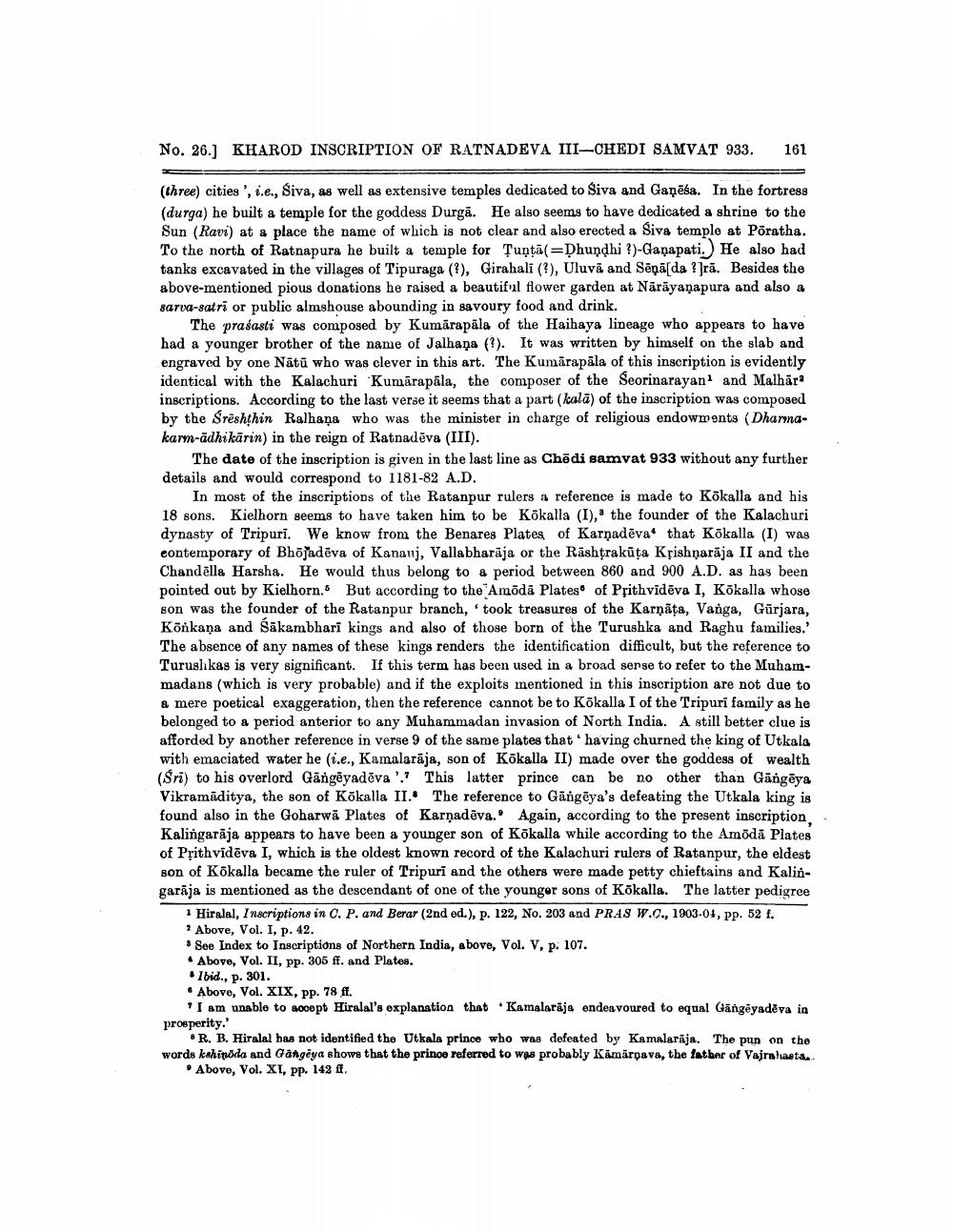________________
No. 26.) KHAROD INSCRIPTION OF RATNADEVA III-CHEDI SAMVAT 933.
161
(three) cities ', i.e., Siva, as well as extensive temples dedicated to Siva and Gaņēša. In the fortress (durga) he built a temple for the goddess Durgā. He also seems to have dedicated a shrine to the Sun (Ravi) at a place the name of which is not clear and also erected a Siva temple at Poratha. To the north of Ratnapura he built a temple for Tuņtā(=Dhundhi ?)-Ganapati. He also had tanks excavated in the villages of Tipuraga (), Girahali (?), Uluvā and Sēnā[da ?]rā. Besides the above-mentioned pious donations he raised a beautiful flower garden at Nārāyaṇapura and also a sarva-satri or public almshouse abounding in savoury food and drink.
The prasasti was composed by Kumārapāla of the Haihaya lineage who appears to have had a younger brother of the name of Jalhana (?). It was written by himself on the slab and engraved by one Nātū who was clever in this art. The Kumārapāla of this inscription is evidently identical with the Kalachuri Kumārapāla, the composer of the Seorinarayan and Malhāra inscriptions. According to the last verse it seems that a part (kalā) of the inscription was composed by the Sreshthin Ralhana who was the minister in charge of religious endowments (Dharmakarm-ādhikarin) in the reign of Ratnadēva (III).
The date of the inscription is given in the last line as Chēdi samvat 933 without any further details and would correspond to 1181-82 A.D.
In most of the inscriptions of the Ratanpur rulers a reference is made to Kökalla and his 18 sons. Kielhorn seems to have taken him to be Kökalla (I),' the founder of the Kalachuri dynasty of Tripuri. We know from the Benares Plates of Karnadēva that Kökalla (I) was contemporary of Bhojadēva of Kanauj, Vallabharāja or the Rashtrakūta Kpishsarāja II and the Chandēlla Harsha. He would thus belong to a period between 860 and 900 A.D. as has been pointed out by Kielhorn. But according to the Amõdā Plates of Prithvidēva I, Kõkalla whose son was the founder of the Ratanpur branch, took treasures of the Karnāta, Vanga, Gürjara, Konkana and Sākambhari kings and also of those born of the Turushka and Raghu families.' The absence of any names of these kings renders the identification difficult, but the reference to Turuslı kas is very significant. If this term has been used in a broad serse to refer to the Muhammadans (which is very probable) and if the exploits mentioned in this inscription are not due to a mere poetical exaggeration, then the reference cannot be to Kökalla I of the Tripuri family as he belonged to a period anterior to any Muhammadan invasion of North India. A still better clue is afforded by another reference in verse 9 of the same plates that having churned the king of Utkala with emaciated water he (i.e., Kamalarāja, son of Kõkalla II) made over the goddess of wealth (Sri) to his overlord Gāngęyadēva'.? This latter prince can be no other than Gäng@ya Vikramaditya, the son of Kõkalla II. The reference to Gängeya's defeating the Utkala king is found also in the Goharwā Plates of Karnadēva. Again, according to the present inscription Kalingarāja appears to have been a younger son of Kõkalla while according to the Amõdā Plates of Prithvidēva I, which is the oldest known record of the Kalachuri rulers of Ratanpur, the eldest son of Kökalla became the ruler of Tripuri and the others were made petty chieftains and Kalingarāja is mentioned as the descendant of one of the younger sons of Kõkalla. The latter pedigree
1 Hiralal, Inscriptions in C. P. and Berar (2nd ed.), p. 122, No. 203 and PRAS W.O., 1903-04, pp. 52 f. 2 Above, Vol. I, p. 42. • See Index to Inscriptions of Northern India, above, Vol. V, p. 107. . Above, Vol. II, pp. 305 ff. and Plates.
Ibid., p. 301. . Above, Vol. XIX, pp. 78 ft.
"I am unable to accept Hiralal's explanation that "Kamalaraja endeavoured to equal Gängeyadēva in prosperity.'
*R. B. Hiralal has not identified the Utkala prince who was defeated by Kamalarāja. The pun on the words kshinoda and Gängeya shows that the prince referred to was probably Kámārpava, the latbar of Vajrahasta
. Above, Vol. XI, pp. 142 ff.




